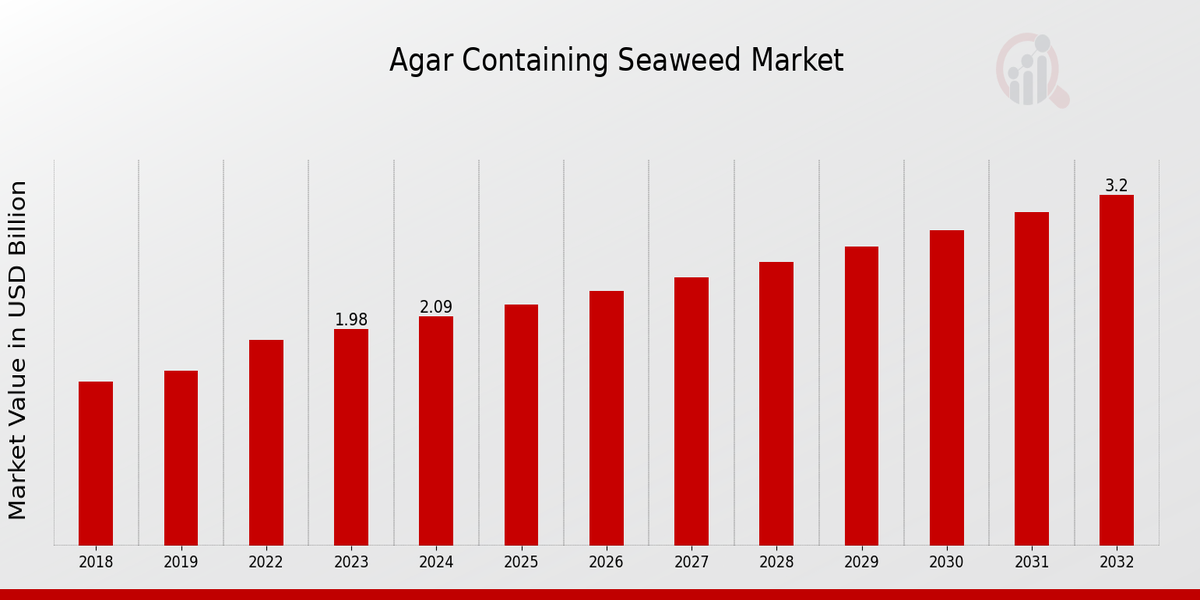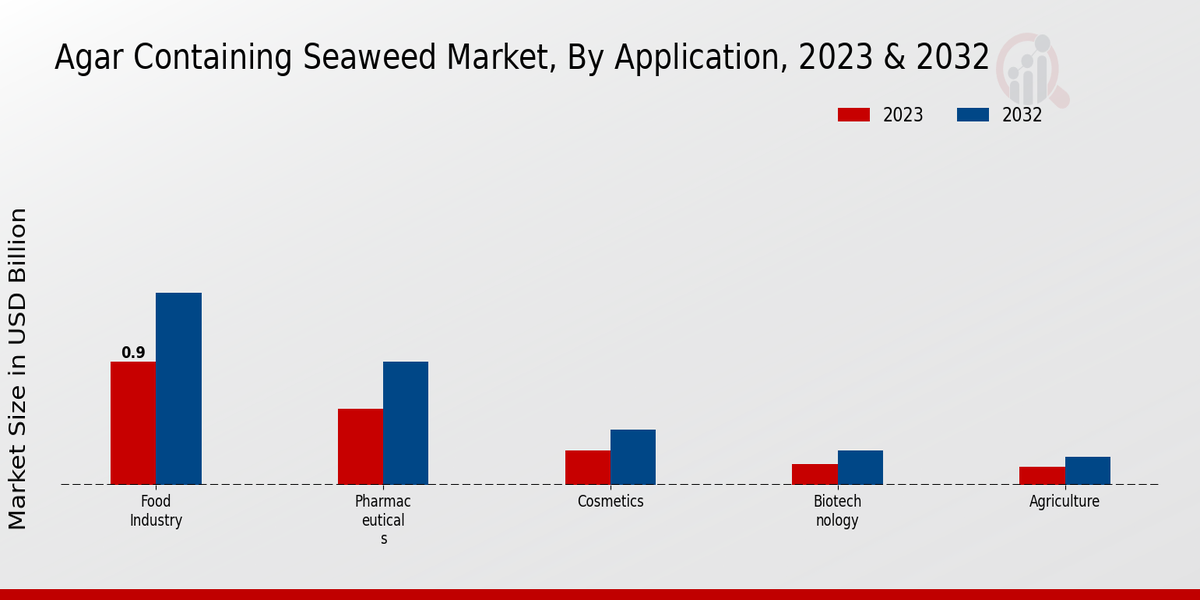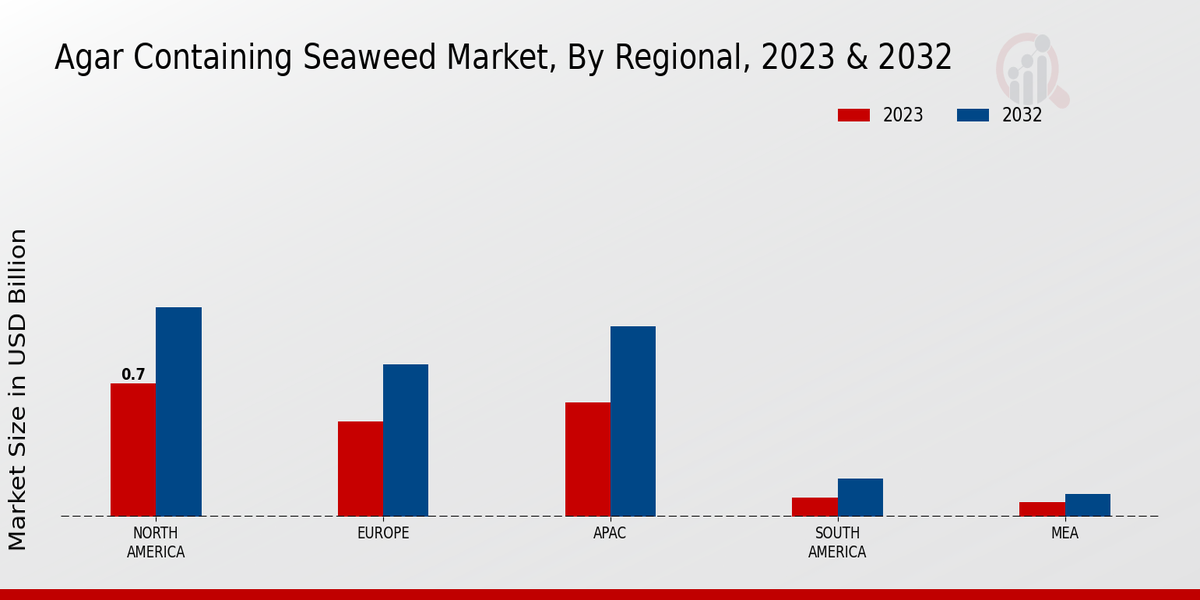Global Agar Containing Seaweed Market Overview
Agar Containing Seaweed Market Size was estimated at 1.88 (USD Billion) in 2022. The Agar Containing Seaweed Industry is expected to grow from 1.98(USD Billion) in 2023 to 3.2 (USD Billion) by 2032. The Agar Containing Seaweed Market CAGR (growth rate) is expected to be around 5.48% during the forecast period (2024 - 2032).

Source Primary Research, Secondary Research, MRFR Database and Analyst Review
Key Agar Containing Seaweed Market Trends Highlighted
The Agar Containing Seaweed Market is witnessing significant growth due to various factors. Increasing health consciousness among consumers is driving the demand for natural and plant-based food additives, with agar being a popular choice due to its gelling properties and versatility in cooking. Additionally, the rise of vegan and vegetarian diets has further contributed to the market expansion, as agar serves as an alternative to gelatin derived from animal products. The food and beverage industry is leveraging agar for its ability to enhance texture and stability in products, making it a key ingredient in desserts, jellies, and sauces.
There are numerous opportunities available in this market. The growing trend of clean labeling and the demand for organic products present avenues for manufacturers to innovate and expand their product offerings. As consumers increasingly seek out sustainable and environmentally friendly ingredients, companies can invest in eco-friendly harvesting practices and promote the benefits of agar sourced from responsibly managed seaweed farms. Emerging markets in Asia Pacific and Latin America are also ripe for development, providing avenues for growth as awareness of agar's benefits increases in these regions. Recent trends indicate a shift toward the use of agar in plant-based alternatives for dairy products and meat.
As the food industry embraces healthier and sustainable options, agar is gaining attention as an effective thickening agent for plant-based yogurts, cheeses, and meat substitutes. The rise of e-commerce platforms is also influencing purchasing trends, allowing consumers greater access to agar products and increasing their visibility in the market. In sum, the Agar Containing Seaweed Market is positioned for growth, driven by health trends, sustainability, and innovation in food technology.
Agar Containing Seaweed Market Drivers
Rising Demand for Vegan and Plant-Based Ingredients
The Agar Containing Seaweed Market Industry is witnessing a significant surge in demand due to the increasing consumer preference for vegan and plant-based products. As more individuals adopt vegetarian and vegan lifestyles, the need for natural, plant-derived ingredients has escalated. Agar, derived from seaweed, serves as a vital thickening agent and gelling agent for various food products, making it a popular choice in the food processing industry.
The switch from animal-derived to plant-based alternatives not only supports ethical consumption but also aligns with a growing interest in health and sustainability. As manufacturers pivot to meet the needs of a health-conscious and environmentally aware consumer base, the integration of agar into their product lines bolsters the position of the Agar Containing Seaweed Market. The ability of agar to enhance texture while retaining clean-label characteristics appeals to consumers who seek transparency in their food choices.
Additionally, the versatility of agar allows it to be used across a myriad of applications, from desserts to soups, thereby further solidifying its essential role in the food industry. This trend is amplified by the rising awareness surrounding health benefits associated with plant-based diets, contributing to the positive trajectory of the market. Future growth prospects show promise as health campaigns promote the idea of natural ingredients in food products, echoing the sentiments of consumers who are increasingly reading labels and opting for familiar, natural additives over synthetic ones.
Consequently, the rising demand for vegan and plant-based ingredients is a fundamental driver promoting the expansion of the Agar Containing Seaweed Market.
Growth in the Cosmetics and Personal Care Industry
The Agar Containing Seaweed Market Industry is experiencing growth owing to the expansion of the cosmetics and personal care industry. Agar is utilized in various formulations, including masks, creams, and gels due to its excellent binding and thickening properties. With the rise of clean and natural beauty products, consumers are increasingly looking for ingredients that are safe, effective, and derived from nature. Agar, being a plant-based ingredient, fits well within this growing trend, leading to a wider adoption among cosmetic manufacturers.
The increasing awareness about the harmful effects of synthetic chemicals has accelerated this trend, as consumers opt for products containing agar, which is perceived as a safer alternative.
Increasing Application in the Pharmaceutical Industry
The Agar Containing Seaweed Market Industry is also driven by the increasing applications of agar in the pharmaceutical sector. Agar is known for its gelling properties, which make it an important component in microbiological media and drug delivery systems. As the pharmaceutical industry continues to advance, the requirement for high-quality, reliable ingredients like agar is on the rise. The growing trend of using natural alternatives in drugs and vaccines also bolsters the market as researchers and pharma companies lean towards the natural sourced ingredients for various applications.
Agar Containing Seaweed Market Segment Insights
Agar Containing Seaweed Market Application Insights
The Agar Containing Seaweed Market, particularly within the Application segment, is showcasing notable growth and diversification across various industries. The Food Industry represents a majority holding in this market, with a valuation of 0.9 USD Billion in 2023, projected to rise to 1.4 USD Billion in 2032. This growth is spurred by increasing consumer demand for plant-based food ingredients and natural thickening agents, positioning agar as a preferred alternative. Following closely, the Pharmaceuticals segment, valued at 0.55 USD Billion in 2023 and expected to reach 0.9 USD Billion by 2032, plays a vital role in drug formulation, benefiting from the rising requirement for gelatin substitutes and gelling agents in the development of various pharmaceutical products.
The Cosmetics segment, while smaller with a valuation of 0.25 USD Billion in 2023 projected to reach 0.4 USD Billion in 2032, is gaining traction due to the growing popularity of natural and organic beauty products. Agar's properties, such as emulsifying and thickening capabilities, make it increasingly important in the formulation of creams and lotions, reflecting trends towards sustainability in consumer preferences. In the Biotechnology space, this segment is valued at 0.15 USD Billion in 2023, with a growth forecast to 0.25 USD Billion by 2032. Here, agar is recognized for its critical role in microbiological culture media, offering a stable environment for various biological research applications, which enhances its significance in scientific advancement.
Agriculture, although the smallest segment with a valuation of 0.13 USD Billion in 2023 and a projected increase to 0.2 USD Billion by 2032, is starting to attract interest due to agar's potential as a biostimulant in plant growth, emphasizing its multifunctional use in diverse applications. This segment’s growth is propelled by increasing awareness of sustainable agricultural practices and organic farming trends. Collectively, the Agar Containing Seaweed Market segmentation illustrates robust prospects across these industries, indicating a steady trend towards natural and functional ingredients, aligning with evolving consumer demands for health, wellness, and environmental sustainability. As such, the market exhibits vibrant opportunities for growth and innovation in each application, despite the challenges of sourcing and processing agar, which may impact overall market growth.

Source Primary Research, Secondary Research, MRFR Database and Analyst Review
Agar Containing Seaweed Market Form Insights
The Agar Containing Seaweed Market, valued at 1.98 Billion USD in 2023, showcases a diverse Form segmentation, pivotal to its growth trajectory. Among these forms, Powder, Flakes, Granules, and Sheets play significant roles, catering to varying industry needs. The Powder form is particularly favored for its versatility in food processing and pharmaceuticals, reflecting a strong demand trend. Flakes and Granules also maintain a noteworthy presence, used extensively in culinary applications and research laboratories. Sheets, while smaller in volume, offer unique advantages in specialized applications such as culinary arts and food presentation.
The adaptability of these forms ensures a comprehensive approach in meeting diverse consumer preferences, thus driving overall market growth. As the market evolves, trends indicate a heightened focus on sustainable sourcing and innovative applications, providing new opportunities for the Agar Containing Seaweed Market industry. With expected growth continuing into 2032, the market segmentation remains essential in understanding Agar Containing Seaweed Market data and Statistics related to the consumption and application across multiple sectors.
Agar Containing Seaweed Market Source Insights
The Agar Containing Seaweed Market is expected to be valued at 1.98 USD Billion in 2023 and shows promising growth potential. The Source segment of this market is primarily composed of Red Algae, Green Algae, and Brown Algae, each contributing distinct properties essential for various applications. Red Algae holds a significant position in the market due to its high agar content and usefulness in food and pharmaceutical industries. Green Algae, while not the largest contributor, is gaining traction due to its health benefits and increasing use in dietary supplements.
Brown Algae also plays a key role, particularly in the production of alginates which are important for thickening and stabilizing food products. Overall, the diverse applications of these algae types fuel the market growth and cater to an array of sectors including food, cosmetics, and pharmaceuticals, enhancing the Agar Containing Seaweed Market revenue and providing various opportunities for innovation and expansion. The ongoing trend towards natural and sustainable ingredients further supports the demand for agar derived from these algae sources.
Agar Containing Seaweed Market Distribution Channel Insights
The Agar Containing Seaweed Market, valued at approximately 1.98 USD Billion in 2023, exhibits a robust framework influenced by various distribution channels. The growing preference for convenience has significantly boosted the Online Retail segment, allowing consumers to access a wide variety of agar products from the comfort of their homes. Meanwhile, Supermarkets continue to serve as a traditional yet vital avenue for consumers seeking familiar shopping experiences and instant product availability. Health Stores play an essential role by catering to health-conscious individuals, emphasizing the nutritional benefits of agar-containing seaweed, and promoting organic and natural products.
This segmentation showcases diverse consumer preferences and highlights the importance of each channel in catering to the specific needs of various demographics. The overall market growth is supported by an increasing demand for plant-based ingredients and sustainable products, creating a synergy among these distribution channels, each contributing to the impressive revenue potential of the Agar Containing Seaweed Market. As market dynamics evolve, companies must strategically leverage these channels to maximize reach and consumer engagement.
Agar Containing Seaweed Market Regional Insights
The Agar Containing Seaweed Market is witnessing notable growth across various regions, reflecting strong demand and application in food, pharmaceuticals, and cosmetics. In 2023, the North America region leads with a valuation of 0.7 USD Billion, projected to rise to 1.1 USD Billion by 2032, highlighting its dominant position driven by significant health and wellness trends. Meanwhile, Europe follows with a valuation of 0.5 USD Billion in 2023, with an anticipated growth to 0.8 USD Billion, indicating a growing interest in plant-based alternatives.
The APAC region shows strong potential as well, with a valuation of 0.6 USD Billion in 2023 set to grow to 1.0 USD Billion by 2032, due to increasing consumption of seaweed-based products. South America and MEA represent smaller segments with valuations of 0.1 USD Billion and 0.08 USD Billion respectively in 2023, but they hold opportunities for market expansion given the rising trend in marine-based ingredients. Collectively, the Agar Containing Seaweed Market shows a well-rounded geographical distribution, with North America and APAC demonstrating majority holding and significant growth potential, while each region contributes uniquely to the Agar Containing Seaweed Market data and statistics.

Source Primary Research, Secondary Research, MRFR Database and Analyst Review
Agar Containing Seaweed Market Key Players and Competitive Insights
The Agar Containing Seaweed Market has garnered significant attention as a vital element in various industries, including food, pharmaceuticals, and personal care. Companies operating within this market are increasingly focused on leveraging innovative extraction and manufacturing processes to enhance product quality and sustainability. The competitive landscape is characterized by a mix of established players and emerging firms, all striving to capture market share through diverse product offerings, strategic partnerships, and extensive distribution networks. The demand for agar, derived from seaweed, continues to rise driven by growing consumer awareness regarding health benefits and increasing applications in gelatin substitutes and vegetarian alternatives, prompting businesses to invest in research and development initiatives to sustain their market standing.
DuPont has established a robust presence in the Agar Containing Seaweed Market through its commitment to innovation and quality. The company's emphasis on sustainable sourcing and environmentally friendly practices has earned it a strong reputation among consumers and industry stakeholders. DuPont's extensive research capabilities enable it to develop cutting-edge products tailored to meet the diverse needs of various sectors, enhancing its competitiveness. Furthermore, the company's focus on strategic collaborations with key players in the supply chain allows it to strengthen its market foothold while expanding its product portfolio to include specialized agar blends. This adaptability and foresight have positioned DuPont favorably within the agar market, emphasizing its strengths in technology and sustainability.
The Meron Group has also carved out a significant niche in the Agar Containing Seaweed Market, leveraging its expertise in seaweed processing and product formulation. The company's strong commitment to quality control and rigorous testing protocols ensures that its agar products meet the highest industry standards, fostering trust among its customers. Meron Group's ability to innovate and adapt to the evolving needs of its clients has enabled it to develop a diverse range of agar products tailored for specific applications. Additionally, the company actively engages in strategic partnerships which facilitate access to new markets and broaden its customer base. By maintaining a focus on customer-centric solutions, the Meron Group continues to enhance its position in the agar market, appealing to both domestic and international buyers.
Key Companies in the Agar Containing Seaweed Market Include
-
DuPont
-
Meron Group
-
Gelymar
-
Univar Solutions
-
FMC Corporation
-
Kappa Bioscience
-
Nengyuan
-
Eden Foods
-
Cargill
-
Acadian Seaplants
-
Sambavanam Ceylon
-
Seaweed Solutions
-
Alginate International
-
Maple Island
-
Algix
Agar Containing Seaweed Market Industry Developments
Recent developments in the Agar Containing Seaweed Market have indicated robust growth driven by increasing demand across various industries such as food and beverage, pharmaceuticals, and cosmetics. Companies like DuPont and Cargill are exploring innovative applications of agar in food preservation and plant-based products, thus expanding their market outreach. Meanwhile, the Meron Group and Gelymar are investing in research and development to enhance agar processing technologies to meet evolving consumer preferences. Additionally, FMC Corporation has announced plans to increase its production capacity, correlating with the rising demand for sustainable ingredients in the market. Current trends highlight the significance of sustainable sourcing, with companies like Acadian Seaplants and Seaweed Solutions focusing on eco-friendly harvesting practices. Notably, Kappa Bioscience's recent partnership with Univar Solutions aims to streamline distribution channels for agar products, enhancing availability for consumers. In terms of mergers and acquisitions, there have been strategic movements among key players, reflecting a proactive approach to market consolidation and competitive advantage, although specific transactions remain confidential. Overall, the Agar Containing Seaweed Market is witnessing dynamic changes that could reshape its landscape, propelling growth across multiple sectors.
Agar Containing Seaweed Market Segmentation Insights
Agar Containing Seaweed Market Application Outlook
Food Industry
Pharmaceuticals
Cosmetics
Biotechnology
Agriculture
Agar Containing Seaweed Market Form Outlook
Powder
Flakes
Granules
Sheets
Agar Containing Seaweed Market Source Outlook
Red Algae
Green Algae
Brown Algae
Agar Containing Seaweed Market Distribution Channel Outlook
Online Retail
Supermarkets
Health Stores
Agar Containing Seaweed Market Regional Outlook
North America
Europe
South America
Asia Pacific
Middle East and Africa
| Report Attribute/Metric |
Details |
| Market Size 2022 |
1.88(USD Billion) |
| Market Size 2023 |
1.98(USD Billion) |
| Market Size 2032 |
3.2(USD Billion) |
| Compound Annual Growth Rate (CAGR) |
5.48% (2024 - 2032) |
| Report Coverage |
Revenue Forecast, Competitive Landscape, Growth Factors, and Trends |
| Base Year |
2023 |
| Market Forecast Period |
2024 - 2032 |
| Historical Data |
2019 - 2023 |
| Market Forecast Units |
USD Billion |
| Key Companies Profiled |
DuPont, Meron Group, Gelymar, Univar Solutions, FMC Corporation, Kappa Bioscience, Nengyuan, Eden Foods, Cargill, Acadian Seaplants, Sambavanam Ceylon, Seaweed Solutions, Alginate International, Maple Island, Algix |
| Segments Covered |
Application, Form, Source, Distribution Channel, Regional |
| Key Market Opportunities |
Rising demand in food industry, Expansion in pharmaceutical applications, Growth in cosmetics sector, Increasing vegetarian and vegan trends, Sustainable packaging innovations |
| Key Market Dynamics |
Rising demand for plant-based products, Increasing application in food industry, Growing awareness of health benefits, Expanding cosmetic and skincare uses, Technological advancements in extraction methods |
| Countries Covered |
North America, Europe, APAC, South America, MEA |
Frequently Asked Questions (FAQ) :
By 2032, the Agar Containing Seaweed Market is expected to be valued at 3.2 USD Billion.
The expected CAGR for the Agar Containing Seaweed Market from 2024 to 2032 is 5.48%.
North America is projected to have the largest market share, estimated at 1.1 USD Billion by 2032.
The Food Industry segment is projected to reach a market value of 1.4 USD Billion by 2032.
Key players in the market include DuPont, Meron Group, Gelymar, and Univar Solutions.
The Pharmaceuticals segment is estimated to reach a market size of 0.9 USD Billion by 2032.
The projected market value for the Cosmetics application is expected to reach 0.4 USD Billion by 2032.
The market value for the APAC region is expected to be 1.0 USD Billion by 2032.
The Agriculture application segment is expected to reach a market value of 0.2 USD Billion by 2032.
The Biotechnology application is projected to reach a market size of 0.25 USD Billion by 2032.

















